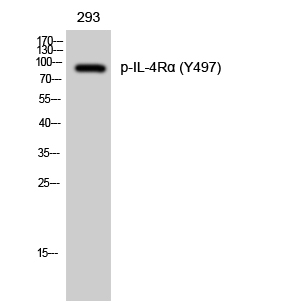Total IL-4R/CD124 Cell-Based Colorimetric ELISA Kit
- 货号:KA4137C
- 应用:ELISA
- 种属:Human;Mouse
- 基因名称:
- IL4R
- Human Gene Id:
- 3566
- Human Swiss Prot No:
- P24394
- Mouse Swiss Prot No:
- P16382
- 储存:
- 2-8°C/6 months
- 其他名称:
- Interleukin-4 receptor subunit alpha (IL-4 receptor subunit alpha) (IL-4R subunit alpha) (IL-4R-alpha) (IL-4RA) (CD antigen CD124) [Cleaved into: Soluble interleukin-4 receptor subunit alpha (Soluble IL-4 receptor subunit alpha) (Soluble IL-4R-alpha) (sIL4Ralpha/prot) (IL-4-binding protein) (IL4-BP)]
- 检测方法:
- Colorimetric
- 背景:
- domain:Contains 1 copy of a cytoplasmic motif that is referred to as the immunoreceptor tyrosine-based inhibitor motif (ITIM). This motif is involved in modulation of cellular responses. The phosphorylated ITIM motif can bind the SH2 domain of several SH2-containing phosphatases.,domain:The box 1 motif is required for JAK interaction and/or activation.,domain:The extracellular domain represents the IL4 binding protein (IL4BP).,domain:The WSXWS motif appears to be necessary for proper protein folding and thereby efficient intracellular transport and cell-surface receptor binding.,function:Receptor for both interleukin 4 and interleukin 13. Couples to the JAK1/2/3-STAT6 pathway. The IL4 response is involved in promoting Th2 differentiation. The IL4/IL13 responses are involved in regulating IgE production and, chemokine and mucus production at sites of allergic inflammmation. In certain cell types, can signal through activation of insulin receptor substrates, IRS1/IRS2.,function:Soluble IL4R (sIL4R) inhibits IL4-mediated cell proliferation and IL5 up-regulation by T-cells.,online information:The Singapore human mutation and polymorphism database,polymorphism:Allelic variants in IL4RA are associated with a susceptibility to atopy, an immunological condition that can lead to clinical symptoms such as allergic rhinitis, sinusitis, asthma and eczema.,PTM:On IL4 binding, phosphorylated on C-terminal tyrosine residues. Phosphorylation on any one of tyrosine residues, Tyr-575, Tyr-603 or Tyr-631, is required for STAT6-induced gene induction.,PTM:The soluble form (sIL4R/IL4BP) can also be produced by proteolytic cleavage at the cell surface (shedding) by a metalloproteinase.,similarity:Belongs to the type I cytokine receptor family. Type 4 subfamily.,similarity:Contains 1 fibronectin type-III domain.,subunit:The functional IL4 receptor is formed by initial binding of IL4 to IL4R. Subsequent recruitment to the complex of the common gamma chain, in immune cells, creates a type I receptor and, in non-immune cells, of IL13RA1 forms a type II receptor. IL4R can also interact with the IL13/IL13RA1 complex to form a similar type II receptor. Interacts with PIK3C3 (By similarity). Interacts with the SH2-containing phosphatases, PTPN6/SHIP1, PTPN11/SHIP2 and INPP5D/SHIP (By similarity). Interacts with JAK1 through a Box 1-containing region. In Th1 cells, binds the N-terminal 50 amino acids of SOCS5, which inhibits JAK1 interaction, STAT6 activation and Th2 cell differentiation. SOCS5 interaction is independent of tyrosine phosphorylation.,tissue specificity:Both isoform 1 and isoform 2 are highly expressed in activated T-cells.,
- 功能:
- negative regulation of immune system process, positive regulation of immune system process, regulation of leukocyte activation, negative regulation of leukocyte activation, positive regulation of leukocyte activation, regulation of adaptive immune response, regulation of adaptive immune response based on somatic recombination of immune receptors built from immunoglobulin superfamily domains, regulation of T-helper 1 type immune response, regulation of T-helper 2 type immune response, immune response, regulation of CD4-positive, alpha beta T cell differentiation,negative regulation of CD4-positive, alpha beta T cell differentiation, positive regulation of CD4-positive, alpha beta T cell differentiation, regulation of T cell differentiation, negative regulation of T cell differentiation, positive regulation of T cell differentiation, negative regulation of cell differentiation, positive re
- 细胞定位:
- Cell membrane; Single-pass type I membrane protein.; [Isoform 2]: Secreted.
- 组织表达:
- Isoform 1 and isoform 2 are highly expressed in activated T-cells.
- June 19-2018
- WESTERN IMMUNOBLOTTING PROTOCOL
- June 19-2018
- IMMUNOHISTOCHEMISTRY-PARAFFIN PROTOCOL
- June 19-2018
- IMMUNOFLUORESCENCE PROTOCOL
- September 08-2020
- FLOW-CYTOMEYRT-PROTOCOL
- May 20-2022
- Cell-Based ELISA│解您多样本WB检测之困扰
- July 13-2018
- CELL-BASED-ELISA-PROTOCOL-FOR-ACETYL-PROTEIN
- July 13-2018
- CELL-BASED-ELISA-PROTOCOL-FOR-PHOSPHO-PROTEIN
- July 13-2018
- Antibody-FAQs


